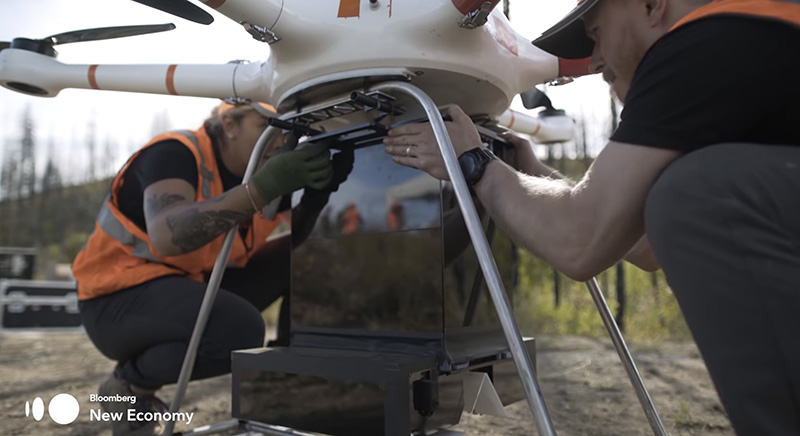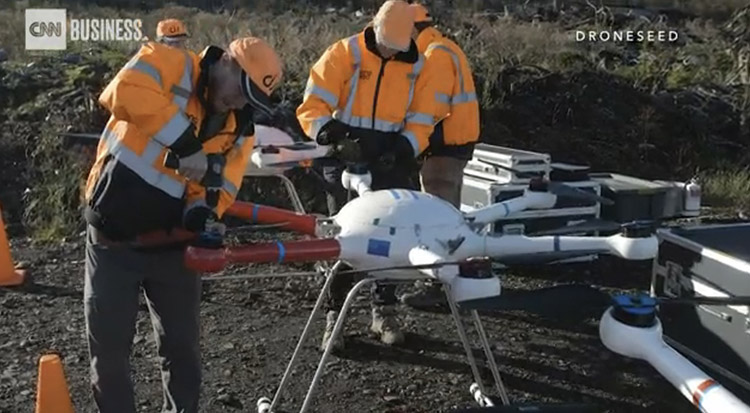Updated December 7, 2020 | 8:20 p.m. PST

DroneSeed, a company that uses fleets of drones to reforest areas burned in wildfires, received approval in October from the Federal Aviation Administration (FAA) for its heavy-lift drones to operate Beyond Visual Line of Sight (BVLOS) and to expand its use of heavy-lift drone swarms to California, Colorado, Montana, Nevada, Arizona and New Mexico. They previously had FAA authorization to operate in Oregon, Washington, and Idaho.
The FAA’s action allows DroneSeed to begin reforesting once a fire is contained and airspace is clear. Their aircraft drop seeds that are encapsulated in vessels consisting of four to six seeds, fertilizer, natural pest deterrents, and fibrous material which absorbs water and increases survivability.
The company has designed a system around a swarm of drones that can drop tree seeds in places where they have a decent chance of survival. First they survey the area with a drone using lidar and a multispectral camera to map the terrain and the vegetation. The next step is to use artificial intelligence to sort through the mapping data to find areas where a dropped seed is most likely to germinate, in order to avoid, for example, rock, roads, and unburned locations. After the aircraft are launched, the five aircraft operate autonomously as they fly grid patterns.

A swarm of five drones can reseed 25 to 50 acres each day, said Grant Canary, CEO of DroneSeed. While on a seed-dropping mission each drone can stay in the air for 8 to 18 minutes, then returns to the helibase where it is reloaded with seed vessels and the battery is replaced. Mr. Canary said it takes about 6 minutes to replace the battery and the 57-pound seed vessel container.
DroneSeed makes their aircraft, they are not off-the-shelf consumer level drones. Batteries power the electric motors that drive the propellers. When at a work site, the workers bring five batteries for each aircraft which are recharged with a proprietary charging system run off a generator.
The company has about 40 employees, 10 of whom may be manufacturing seed vessels for ongoing or upcoming reseeding projects.
The company is already reforesting some of the areas burned this year in the one million-acre August Complex of fires in Northern California, and the 173,000-acre Holiday Farm Fire in Oregon.
While most aircraft hired by land management agencies are paid by the flight hour and daily availability rates, DroneSeed charges by the acre.
After sites are selected, seed vessels are manufactured, in many cases containing native Douglas Fir or Ponderosa Pine seeds harvested from the general part of the country where they will be later dispersed.
Currently DroneSeed is the only company in the United States approved to operate with heavy-lift drone swarms, according to the company.
The video below describes the reseeding system beginning at 0:32 and ending at 3:52.
Thanks and a tip of the hat go out to Rick.

As a forester / silviculturist I cringed when I read that they used seed from ” generally in the area”. Our science in this area indicates need for a lot closer area of origin for what is being planted. I would applaud the effort but feel the effort is counter to good science with use of the general seed.
Do not assume that the seeds come from a long distance away.
I did not assume that they came from a “long distance away”. What I did assume is that they would likely come from a source that does not match the elevation, slope aspect or other micro climate factors that trained professionals use in selecting a seed species and source. Planting an incorrect species or seed source may give you a viable healthy forest or a forest of stunted trees. And you will not know for 10 to 20 years that you screwed up.
When I worked for USFS Timber Management in the late fifties and early sixties, those factors were required, and seed lots were so identified. I believe the practice went back a lot farther than that, but since I don’t know enough about the history of those practices, I will not deign to comment further. As to this practice (aerial seeding), I remain suspicious, but as I have been chastised for failing to cite specific references to back up my comment and requested assistance from the Forum with my faulty memory with respect to it being done in the forties or fifties before, I remain unable to remember sufficiently accurate information to qualify for re-posting it. I hesitate to use the Wikipedia entry, as I consider some of it to be flawed, but this quote may shed some light: “History
According to the National Agricultural Aviation Association, the birthplace of aerial seeding in America happened 1921 in Ohio. Lt. John A. Macready, a U.S. Army pilot, used a modified Curtis JN-6 to dust a field of catapla trees with arsenate to kill sphinx moth larvae.[5] This early crop dusting lead to aerial seeding.
Aerial reforestation, a type of aerial seeding, specifically to repopulate forest land after some type of disaster was being used as early as the 1930s. Planes were used to seed mountain areas in Honolulu that were inaccessible to traditional methods after forest fires.[6]
By 1946 aerial seeding was being used in Oregon to seed more than 500 acres of Douglas fir, and Port Orford cedar as well as 100 acres of grassland and other trees that were burned by fire. In 1947 the Crown Zellerbach Corporation seeded over 1000 acres in Oregon.[7]
Surplus planes from World War II were initially used for aerial seeding, with the open cockpit Stearman biplane used frequently. Because many veterans were trained to fly these planes, this led the way for many people to develop a business around aerial applications. Today professionals use planes powered by turboprop engines and are navigated by GPS for better accuracy.[7] ” https://en.wikipedia.org/wiki/Aerial_seeding
In my decades of experience of failures and successes with ecosystem restoration, before finally getting it more right than less, I found that the pure live seed (PLS) cost was greater than hand-planting for some species while in most cases broadcast seeding was cheaper and better, given the right proportions of species, so I would be curious about references to cost-effectiveness studies. I also have found that in some contexts, serious damage to an ecosystem restoration can be done by broadcast seeding of some species, while in other cases, one is simply wasting expensive seed, given poor survival rates and predation. I look forward to more specific (and accurate) information from others wwon this practice and studies on performance in particular.
Aerial reseeding of trees has changed significantly since the 1930 to 1960 era.
As it says in the article above, Droneseed does not just drop bare, naked seeds on the ground. “Their aircraft drop seeds that are encapsulated in vessels consisting of four to six seeds, fertilizer, natural pest deterrents, and fibrous material which absorbs water and increases survivability.”
A video at CNN has images of seedlings sprouting from the vessels, beginning at 3:00.
https://www.cnn.com/videos/cnnmoney/2017/08/14/tree-planting-drones-fight-deforestation.cnn-tech
Here’s the magazine piece I was trying to remember https://books.google.com/books?id=0N4DAAAAMBAJ&pg=PA165#v=onepage&q&f=false
It was for grass, not trees, but “pellets” were used. Yes, of course one would expect that the technology would have changed in the last seventy years or so, but from what I can discern from the material at hand, I don’t see solid scientifically accurate information that it has changed all that much.
What really might advance the discussion is a testable hypothesis and reproduction of results, including cost-effectiveness and effects on the ecosystem from which the seed was collected. Charley was only pointing out the absence of evidence.
Aren’t there already seeds in the ground or wete the fires so hot even closed cone conifer seed and other soil seed banks were destroyed?
What is the survival rate of these dropped seeds vs. the survival rate of planted seeds by a human? The article mentions that the swarms can plant between 25 and 50 acres of seeds per day. (That’s a large variable?) And that a human can only do 2 to 3 acres per day. If the human is just dropping seeds I guarantee they can do more than 3 acres per day. If the human is planting seeds versus the drone dropping seeds, I believe that is not fair comparison. There is certainly a place for this technology. Especially the seed coating aspect. We need more information.
The video, not the article, says, “human planters can do about 2 to 3 acres a day”. Reforestation is rarely done by humans scattering or planting tree seeds. They carry bare root seedlings which are planted in holes dug in the soil.
The number of acres reseeded per day by the drones depends on the prescription, according to Grant Canary, CEO of DroneSeed.
I’m guessing James is referring to the rule that federal agencies can’t use federal funds for drones manufactured by certain foreign companies (i.e. DJI) unless the agency demonstrates it has procedures to ensure data integrity. (see here: https://dronelife.com/2020/10/09/no-federal-funds-for-dji-drones-doj-makes-the-ban-official-but-some-federal-agencies-may-suffer/ ) His concerned is misplaced since the tree planting drones are custom built.
but yet they wont let the forest service use them (besides fire operations) due to the video and information going directly to china through software?
What is the source of your information?
I HOPE THEY’RE REDUCING THE FUEL LOADES IN AREAS THEY ARE PLANTING. IF NOT, THEY ARE MOST LIKELY JUST PLANTING FUEL FOR THE NEXT FIRE.
A MIRACLE! A MIRACLE! A MIRACLE!